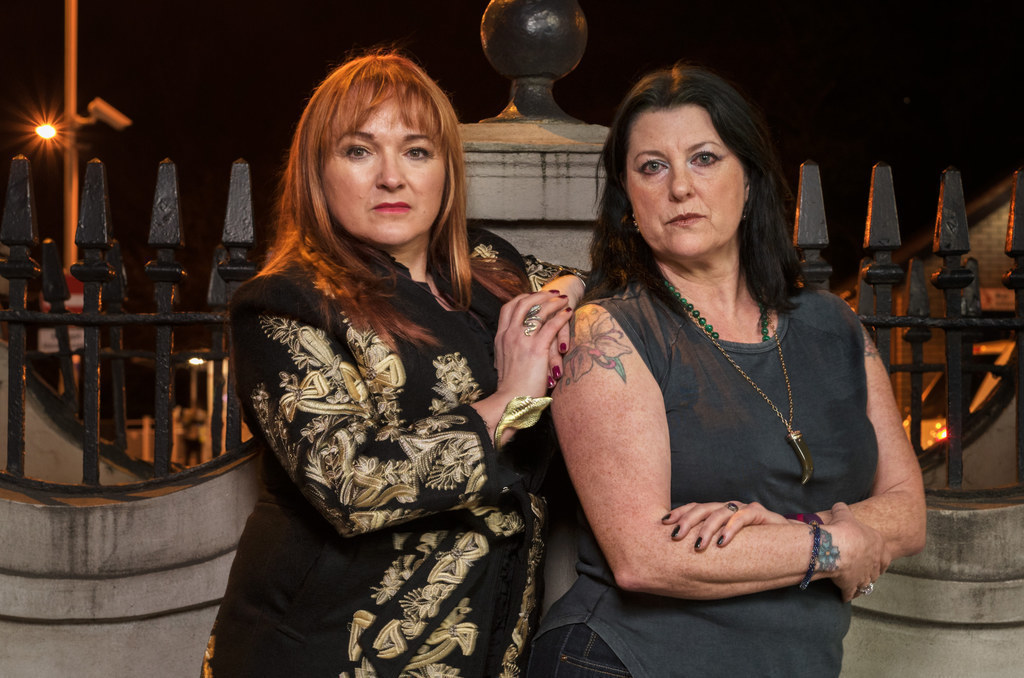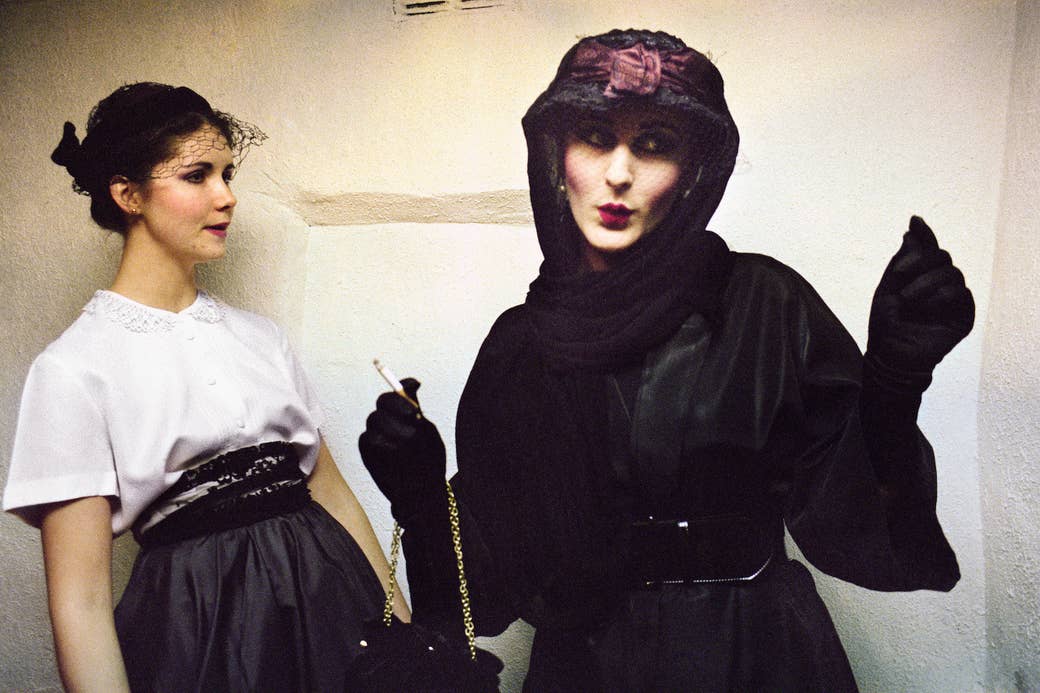
In 1980, young hopeful photographer Anita Corbin started taking pictures of other young women in London's pubs and clubs, documenting the unseen lives of various subcultures. Over the course of nine months her project turned into a series, Visible Girls, that offered a glimpse into the worlds of punks, mods, skinheads, rastas, and rockers.
The Visible Girls exhibition of 28 double portraits toured the country in the 1980s and 1990s, and the images stood out as rare pieces of social history, showing women from youth tribes in their natural environments. However, Corbin lost touch with the women themselves.

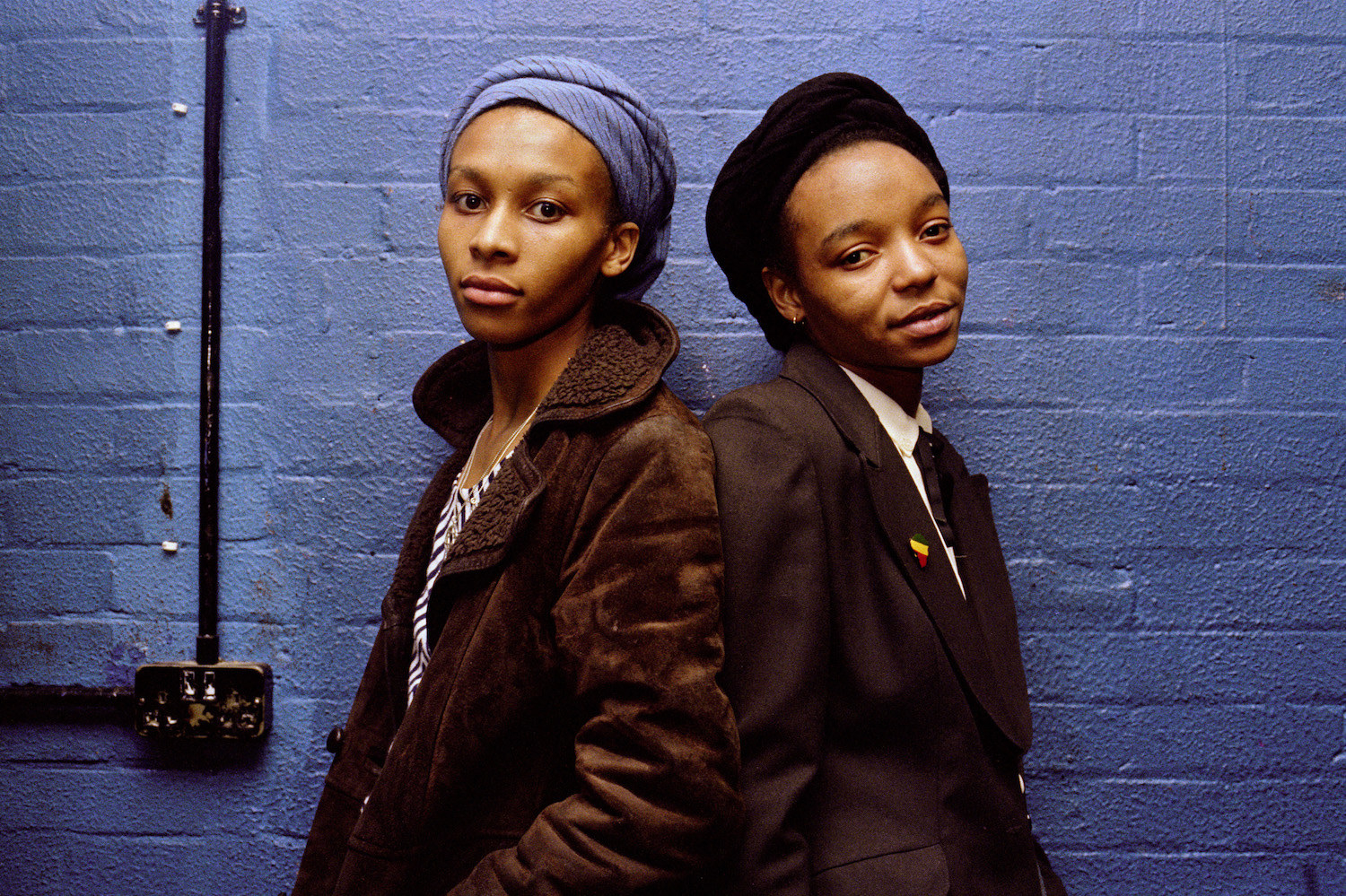

Then, in 2014, BuzzFeed News published a series of the images after they were shared on Tumblr. This turned out to be the catalyst for Corbin reconnecting with the visible girls – now all middle-aged women – and one by one they started to get in touch with her.
Corbin has now interviewed more than a third of them for an exhibition of new portraits and the original pictures that opens on Thursday at the Artlink gallery in Hull as part of the 2017 City of Culture programme. It will then tour the country, and Corbin has launched a crowdfunding campaign to bring the exhibition to more towns and cities in Britain. She is now in contact with 70% of the original women photographed, and plans to photograph more of them by the end of 2018.
"It was a bit of a dream that I had," Corbin tells BuzzFeed News. "I did try to do it in 1991 but I couldn’t find any of them. All the numbers had changed or they’d moved away, so I let it go dormant for about 25 years. And it wasn’t until your piece came out that I thought, This is a possibility now.
"And in the last three years even more connections have happened because of technology. I think BuzzFeed was the catalyst and then I subsequently had the show last year and lots of press through that. Social media and media coverage has allowed me to find them, or them to find me."
Some of the women featured in the original series hadn't seen each other for decades and were reunited by the project. One, Mary, who was half of a pair of mods, googled "mod" to find out the name of a song and found BuzzFeed's article, before contacting Corbin. By chance, Sandra, the other half of the pair, also got in touch just days later.
"So they’re now reconnected through the Visible Girls project, which in a way is what it’s all about," says Corbin. "You know, rekindling those old friendships, those strong bonds of young women, that idea of ‘me and her against the world'.
"That’s been the most exciting and joyous feeling, when you can actually be a catalyst for these people coming together and reconnecting with their younger selves.
"It’s not about saying it was wonderful in the good old days, it’s just about connecting with a younger version of yourself. It was a period in our lives when we were starting a new phase."
Here, some of the women featured in the exhibition tell their stories in their own words:
Carrie Kirkpatrick (left): I got into punk first at the age of 12 and went really quite wild with it. It was this massive energy, a means of escape from difficult situations at home. I didn’t really know what punk meant, but I found it really empowering. Going to gigs and drinking and taking drugs was exciting, another identity that was much more me. I felt free.
I was in so deep with punk that I was getting into trouble with the police. At that point there was a whole skinhead revival, and Gill suggested we get into it. It was easier to be part of that scene, and we didn’t have any trouble any more because skinheads were somehow more structured by nature, not so wild. It was all more clipped, with smart clothes, perfect hair, and nails. Perhaps because of its working-class community roots, it was a lot more straight-as-a-die.
The politics at the time were dreadful. I lived in south London – I grew up surrounded by right-wing views and the reason for that was sociological. South London had seen a lot of immigration in certain areas and it was very much a "them and us" attitude. I spent a lot of time making sure I deprogrammed my conditioning around racism. In our skins group, we were conscious of it [racism] being all around, but actually our lot weren't really that bothered with it. I've become cautious of people who have never moved on from that time.
Gill Soper (right): It was good fun being a skin. It was rebellious and different. Between '78 and '79 there was so many [subcultures] to choose from: punk, disco, reggae, the mod revival, 2 Tone. And when you're young you're fickle and you latch on to the newest thing, which for us was being a skinhead. Everyone I knew was a punk one day – then shaving their head and wearing jeans and braces the next.
It was the clothes that drew me – well, if I’m honest, it was actually the fellas to start with. But closely followed by the clothes and the music and the attitude. It was a hard look – I wasn’t aggressive, but it was strong. When we all went out together it felt so good. We all had suits made. There were the shirts, the feather cuts, and the shoes. But I didn’t feel like the skins were my family. There was a sense of belonging I suppose, but it was more like an escape. I guess the clothes, the music, the scene, the group, it all offered life a bit of structure.
I was a punk originally, but I couldn’t go the whole hog with it because I was also into disco. If you turned up at a disco event with a blue mohican you wouldn’t be so welcome.
Susan Stecker (right): [My sister Linda and I] weren’t part of a subculture really. I was 16 then, too young then to be aware of what subcultures were. But we wouldn't have been scared of a punk or crossed the street if we saw some. I don’t remember ever being frightened or feeling intimidated by going up to London. I don’t think we were scared of very much really. The world seemed a less scary place back then – either that or it was the courage of youth!
There was quite a lot of us [in our social group], but I was still young and hadn't quite found out who I was and I liked all different sorts of things and it was probably just the start of going out for me.
We wore whatever was in fashion really – I think the sweatshirt I’m wearing was from Miss Selfridge but we also shopped at local boutiques. Going by what I am wearing in this picture, I wasn’t properly clubbing by then – it would have been something better than that horrible jacket!
A lot of the clubs would be playing disco but I also liked Spandau Ballet, Adam and the Ants, Heaven 17, David Bowie, so it was the start of, I suppose, the new romantic stuff. I had my own stereo with cassette and record player and lots of 12-inch singles.
Linda Robinson (left): I remember this photograph being taken but I only saw it for the first time over 30 years later when it was on Facebook. I was hysterical with laughter. I had to call Susan. We were like, "OH GOD HOW AWFUL WE LOOK!" My kids were wondering what on earth I was shrieking on the phone about at 7am.
In my teens, I loved having my photo taken – Southgate station had a photo booth so we would all crowd in there. I had an Instamatic – I was always at Boots getting pictures developed. If I took a photo that I didn’t like I ripped it up and no one would ever see it, but it’s different for my four daughters. I can see the stress they go through, looking at images of themselves on social media, worrying they don’t look good. If someone takes a photo of you now, it's out there forever.
We are Jewish so that was our scene. In our early teens we would hang out at McDonald’s, the Baskin Robbins in Golders Green; we would go to pubs, not drinking but hanging around outside. We’d go to Hampstead and meet at the Milk Churn for a salad or ice cream and hang out there all night, to meet new people, but boys mainly.
Charlotte Wager (left): Tessa and I live on opposite sides of the world now but we have stayed close and that original photograph has always been in the back of my mind, as has that era.
I remember what it felt like to be a mod: exciting, part of something really good, a club, a team, something you looked forward to, planned for, dressed up for. That feeling was much more about my youth, than where I am today – in part because that feeling was also about being young and carefree. That’s not really where I am at now. Which is not to say I’m unhappy, but my friendships and what drive me today are completely different.
Excitement has a different quality now. I run marathons and it's very solitary, but I can absolutely get the same high from training and racing. I have a lovely group of running friends, many of them women, although we don’t socialise. Maybe part of it is that now I feel like an established, successful woman so although I love my girlfriends, I don’t need a web of women to carry me and give me confidence in quite the same way.
In the 1980s I was still a mod but I had also become a CND youth leader. I was very into political activism, campaigning and organising marches, and debating all over the country. There was a bit of tension between that and the mod scene but I was very passionate about both so I made the two work.
Tessa Morton (right): [Charlotte and I] got into this '60s crowd when we were 16 and 17. Then we got into the scooter crowd. And we loved that it was an edgy crowd. We didn’t want people to see that we were middle-class [laughs], we wanted to be seen as a bit Quadrophenia. But we’d go home to nice Sunday lunches and warm beds and parents who didn't quite know what we had been up to.
'60s Motown – we were really into that, and boys with scooters were part of the scene. We had to be on the back of their scooters because the good clubs were dotted all around London. The only problem was, once you got there, if the boys decided to piss off you were left stranded. Charlotte and I were like, ‘Right, we’ll get scooters then – and we can go where we wanna go!’ And it became an identity, this all-girl scooter club called The Rosettes.
At the time I remember thinking, I was going to marry a mod, have a mod house and mod babies. We would be away down to Brighton for the weekend, but I’d tell my parents I was staying at Charlotte’s. As long as they thought I was with Charlotte – another nice middle-class girl from a good school – they were OK.
Sue Lenham (right): Nobody else was into rock 'n' roll when I was at school – it was too retro. My dad brought us up, which was unusual in the 1960s, and my family situation was challenging. I had to be independent and I think the [rocker] scene let me express myself.
I found out later that my dad had been an Edwardian [a particular type of teddy boy]. It turned out we had frequented the same haunts! Unknowingly, I followed in my dad’s footsteps. He had had a challenging upbringing too and was also very independent as a result. Maybe we both saw our subcultures as an escape.
In the early days, Nikki [Nicole] and me would sneak off to Mildenhall air base to practise our dance moves on their great wooden dance floors. The men there assumed we were gay because we danced together, which was good really because we didn’t want any of them bothering us whilst we were practicing.
Nikki has always been in my family of choice. I didn’t get on with my sister and Nikki had experienced considerable family problems, so we were both sort of orphans and became each other's family. I looked out for her.
When we reconnected for the new photograph… Jeez, after 20 years it only took five minutes to realise we were still sisters under the skin. It was bloody awesome.
Nicole Le Strange (left): "I was 18 in this picture, it was 1981. I was a rockabilly – I loved the music, the clothes, the hairstyles, and the dancing. But also, it was my refuge. I experienced the most horrendously abusive childhood, so my subculture was a safe place for me: More than anything else, it was where I was accepted completely.
I grew up being told by my mother that I wasn’t good enough because I wasn’t a boy, because I was ugly, because I was too tall and too skinny. I remember her saying to me, 'If abortions had been legal when I’d got pregnant with you, you wouldn’t even be alive.'
Then I met the people who became my friends [in this rockabilly group] – Sue particularly – and they didn’t try to mould me. They didn’t want me to change. I felt like a superhero. The clothes I wore then certainly weren't a costume – I dressed like that all the time because I wanted to – but it sort of was my "superhero costume"; it was when my outward appearance truly reflected my inner feeling, and I was totally accepted for that.
I had never really liked this photo, but reflecting on it I realised suddenly one day it’s not about how I look, it’s about what that photograph means. There I am at such a hard time in my life, but I am with Sue, the only person in the entire universe who loved me unconditionally. With whom I could (and still can) be exactly who I want to be. Even into my early thirties, I remember watching the movie Thelma & Louise. There’s this one line, “You get what you settle for”, and I realised that until that point that had been my life.
Carol and Nicola at the Tabernacle, Notting Hill Gate, 1981

Nicola (right) and her wife Kelley in Seattle, Washington, 2017
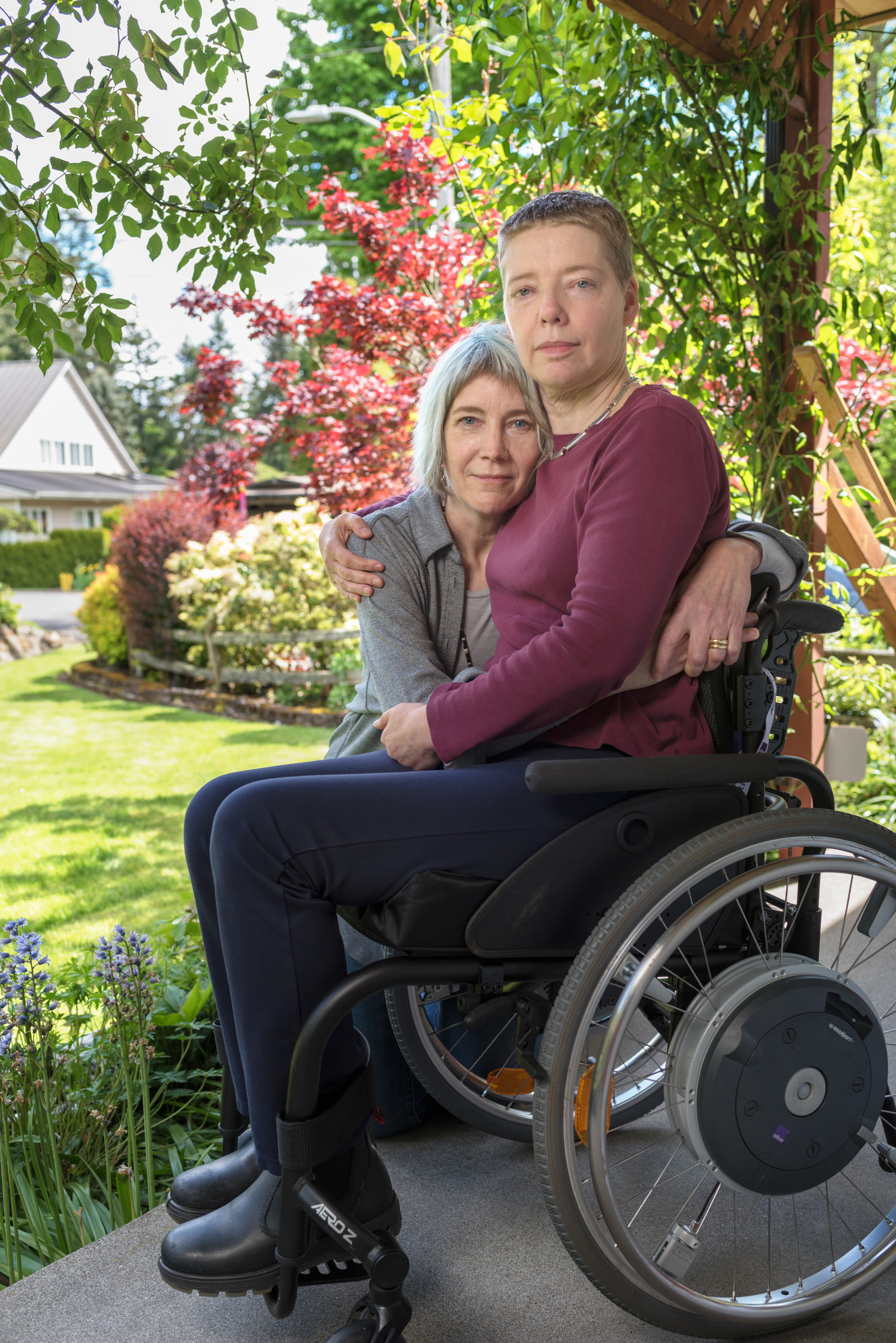
Nicola Griffith: All I remember about that photograph was that I was trying to protect Carol, because about two minutes before she’d been freaking out a bit. We'd been taking magic mushrooms, you know how it goes. Anita came up and said, "Hey, can I take your picture?", and I turned round to say "No!" but Carol beamed and went, "Yeah!"
If I identified with a tribe then I’d say it was lesbian feminist. We did have some signs and signals – the haircut, the women's sign badges, ties and braces – and I wore them because I liked what they stood for: equality. But I also wore them because if you were in the supermarket and you saw someone else with that double women’s sign you’d think, Thank god, I'm not the only one. Not everyone in the room will turn on the dyke and spit.
As we get older we become more ourselves, individuals, and that makes us less tribal –less willing to just go along with things, more likely to ask questions. When I was 19 I hadn't learnt the rules of the tribe and just said stuff. I wasn't very popular. After a year or so I learnt to keep my mouth shut because asking questions was Not Done. But the thing I most disliked about the lesbian feminist ethos was The Collective: not just that we were equal but that we all had do exactly the same, no matter what your particular skills. Everything together all the time. It drove me crazy – ridiculous and just wasteful.
Since then, I've belonged to many tribes. I’m still part of the queer community here in the US, and different writers' communities – science fiction, crip fiction, historical fiction. I’m doing research, and a PhD, so I also mix with historians and academics. There's my neighbourhood community, the online crip community. I'm part of many subcultures now but don’t wholly belong to any.
Carol (left) and her wife Ann in Hull, 2017
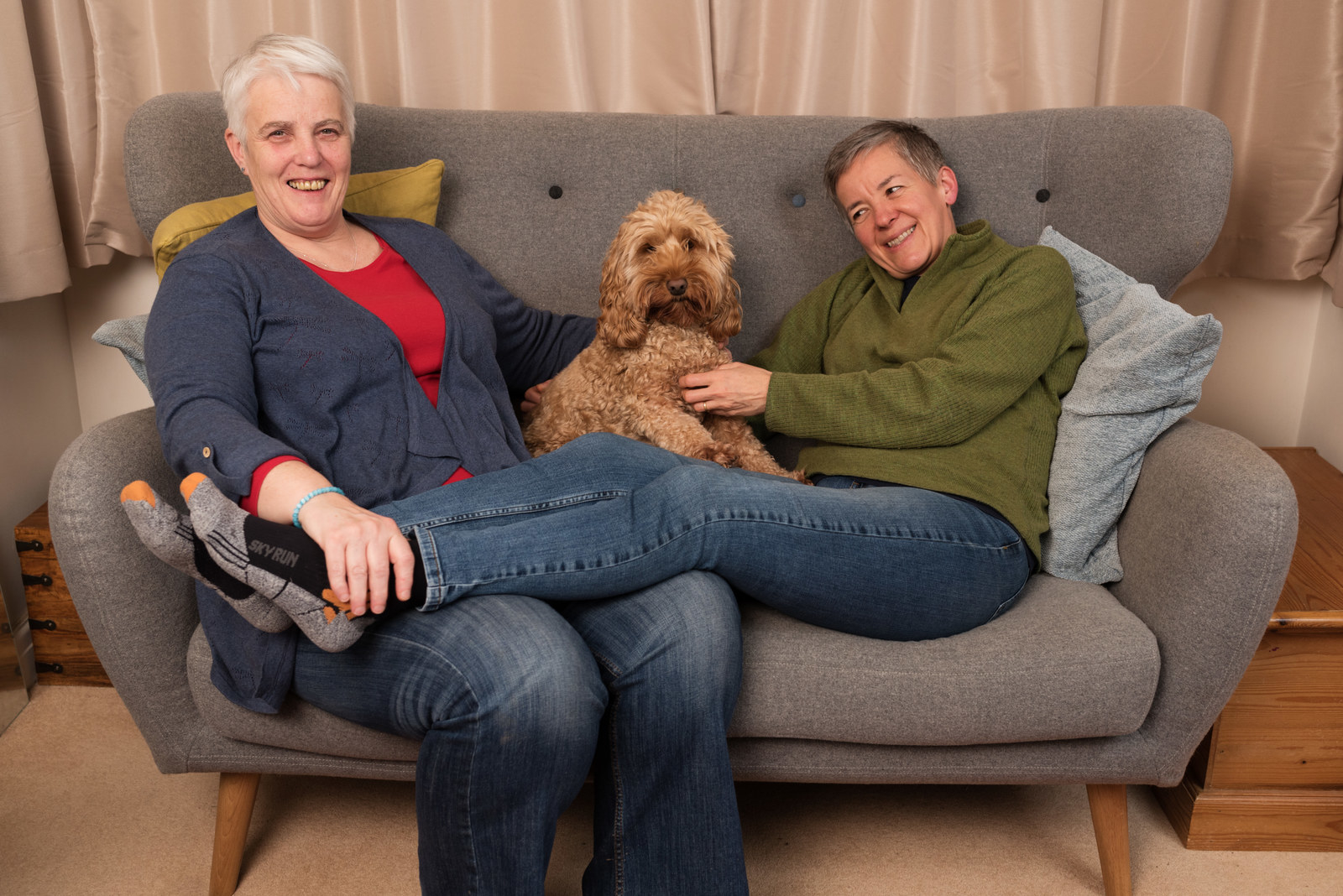
Carole Holmes: That day [when the original photograph was taken] we were at a disco after attending the first national lesbian conference in London. It was exciting – there was such a sense of solidarity. It was important to show people that we weren't just a "little group".
Growing up, I knew there was something inside me that I really needed to understand, but I wasn’t sure what. I knew that I needed to get away from small-town expectations: working in the local factory, getting married, and having Christ knows how many kids. I wouldn’t call what I was doing rebellious. It was, I think, desperation.
My subculture gave me a hook to hang my coat on for a while. It provided a sense of family but in hindsight it wasn’t truly me. The real me was that small town girl, and all of a sudden I’d met all these clever, student feminist lesbians. I was very working-class and they used language I only pretended to understand.
But it was through [the subculture] that I realised, Oh, I'm a lesbian!, and it was important for me to find that tribe. That particular subculture allowed one, true part of me to flourish – but it wasn’t always in alignment with the other parts. People are more complex than their communities."
Visible Girls Revisited is at Hull Artlink from 7 July to 11 August, Exeter Phoenix from 17 November to 21 December, Norwich Arts Centre from 7 February to 14 March, and Bristol 3CA from 6 September to 4 October 2018. More dates will be announced shortly.
Anita Corbin is still trying to contact some of the original Visible Girls. If you can help, find out more at visiblegirls.com.
Interviews with portrait subjects by Deborah Willimott.


